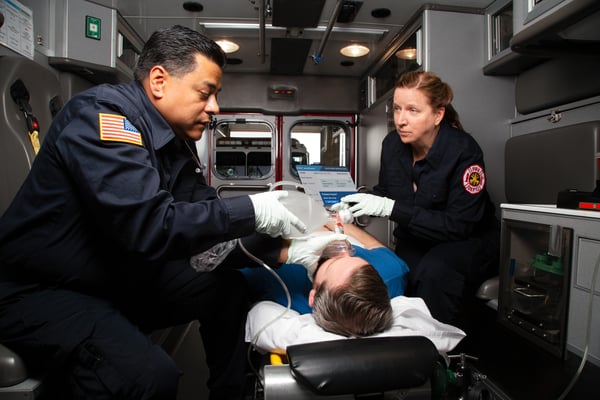News Alert: New ePCR Integration Simplifies EMS Data Management and Enables Better Care Coordination
Participating in the ET3 Model? Here’s What You Need to Know About NEMSIS Reporting Requirements
With thousands of Emergency Medical Services (EMS) agencies throughout the U
Was this information valuable?

With thousands of Emergency Medical Services (EMS) agencies throughout the U.S., there are inevitably hundreds or even thousands of different ways that patient data gets captured, translated, and reported. If agencies inside the same state are not using the same terminology and capturing the same data elements, it is nearly impossible for this data to be analyzed at the state level.

The National Emergency Medical Services Information System (NEMSIS) was designed specifically to solve the problem of data inconsistencies between agencies. It is a national repository for collecting, storing, and sharing standardized EMS data. Agencies must report to NEMSIS using a common methodology that can also be used to share data with other stakeholders. NEMSIS historically released an annual dataset for research, but in 2020, a mid-year dataset was released (2020 NEMSIS Mid-Year Public-Release Research Dataset) due to researchers’ requests for investigating EMS activity during the COVID-19 outbreak.
Beginning January 1, 2021, CMS and a group of selected agencies will be participating in the Emergency Triage, Treat, and Transport (ET3) Model. It is a voluntary, program designed to provide greater flexibility to EMS agencies to address emergency health care needs following a 911 call. CMS will, for the first time, pay participants to transport to an alternative destination partner, such as a primary care office, urgent care clinic, or a community mental health center (CMHC). Participants may also initiate and facilitate treatment in place with a qualified health care partner, either at the scene of the 911 emergency response or via telehealth.
Multiple NEMSIS Version Exports May Be Required
While this is an exciting advance for CMS and participating EMS agencies, it is important for participating agencies to understand the differences between NEMSIS reporting, with which they are already accustomed, and ET3 reporting. ET3 reporting, based on the NEMSIS 3.4 standard, requires an additional data element and two additional data fields. At the same time, there are still the standard state-level compliance and data reporting requirements. Compounding the EMS data reporting complexities, some states (namely, SC, NC, WV, and TX) still require reporting via NEMSIS 3.3.4, even though support for this standard will cease in 2021. And, don’t forget that version 3.5.0 is planned for broad market availability by August 2021, adding one more consideration.
Check Your ePCR Readiness Now
Starting January first, each agency participating in the ET3 initiative must comply with specific CMS data reporting requirements, as well as those of their state and other entities. To do so, and to ensure a smooth launch of the ET3 initiative, it is recommended to work with your ePCR software vendor to ensure that they support exporting to multiple NEMSIS standard versions, including version 3.4 (required for ET3). In addition, state agencies and billing and revenue cycle management (RCM) companies may require other versions. Determine whether your solution supports field data collection and can report it natively via NEMSIS 3.4 without the need for translation or patches. Collection and direct (native) reporting protects data integrity and prevents unexpected results, such as inaccurate descriptions of treatment or protocols due to data loss or corruption during translation.

An ET3-ready ePCR should enable the NEMSIS 3.4 standard with virtually no changes. Reporting via NEMSIS 3.4 is simply a procedural change. Implementation should be as easy as running a simple installer. The new ET3 fields should then automatically appear in the ePCR to guide medics through data collection at the scene.
ET3 NEMSIS Compliance Checklist
To summarize, right now is the time to make sure you have your ducks in order ahead of the January 1 CMS ET3 Model launch. The ET3 initiative will provide new options for treating patients at alternative locations and getting paid. At the same time, EMS will have the perfect platform for showcasing its ability to provide quality, cost-effective care while diverting non-emergent cases from emergency rooms and preserving capacity for critical care. For the CMS ET3 Model to be successful, however, agencies need to make sure they report their activities accurately and compliantly.
Use this checklist to gauge your data reporting readiness:
√ Understand the reporting requirements for CMS ET3 Model.
√ Consult your ePCR vendor to ensure that your software supports NEMSIS 3.4 export. Ask whether data is reported natively, or if a 3.3.4 translation is required.
√ Ensure that your ePCR can export to multiple NEMSIS versions. Pay particular attention if you operated in SC, NC, WV, or TX, where state agencies require NEMSIS 3.3.4.
Consider that NEMSIS 3.5 is on the horizon in 2021 and could add another layer of compatibility requirements to your reporting capabilities.
Read More on NEMSIS Topics
Related Posts
4 Must-have Data Points for Dispatch-Billing Alignment and Maximum Reimbursement
How STAT MedEvac Connected Device, Software, and Data Technology To Enhance QA and Elevate Care
ZOLL Pulse Blog
Subscribe to our blog and receive quality content that makes your job as an EMS & fire, hospital, or AR professional easier.
ZOLL Pulse Blog
Subscribe to our blog and receive quality content that makes your job as an EMS, fire, hospital, or AR professional easier.




